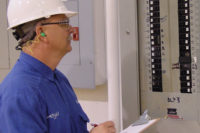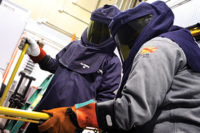- who a Qualified Person is
- it will also identify the training required for a person to be considered qualified.
Electrical injuries and fatalities are still occurring at an alarming rate. Investigations indicate, among other findings, that employees are not always properly trained and qualified to perform the work they are assigned or expected to do.
Maintenance of electrical protective devices, particularly circuit breakers and relays, performed by Qualified Persons, is vital to electrical systems and equipment reliability, and also to the safety of employees working on, near, or with these systems and equipment.
Qualified person requirements
A serious misconception exists throughout industry that a licensed Journeyman or Master Electrician constitutes a Qualified Person. This is not necessarily true. A Journeyman or Master license is obtained through a required number of years working under a licensed electrician (depending on the state, county, or municipality requirements) and passing a National Electrical Code® (NEC) exam.
For example: a licensed Master Electrician may have 20 years of hands-on field experience and qualifications in electrical work for residential or commercial buildings, but he/she would not be experienced or qualified to work in a petrochemical or manufacturing facility and could not be hired as a Qualified Person.
OSHA and NFPA mandate requirements for training and qualifying maintenance employees and must be considered when conducting a training needs assessment. A job/task analysis is needed to identify job/task requirements, write a job description, and identify topics for training. The following definitions will make this clear.
The NEC defines a Qualified Person as “One who has skills and knowledge related to the construction and operation of the electrical equipment and installations and has received safety training to recognize and avoid the hazards involved.” OSHA 29 CFR 1910.399 modifies this definition of a Qualified Person to be more specific: “One who has received training in and has demonstrated skills and knowledge in the construction and operation of electric equipment and installations and the hazards involved.”
Since one of the qualification requirements is being trained in the hazards of the equipment, it must be addressed specifically. OSHA and NFPA 70E have provided strict requirements for safety training that go hand-in-hand with the qualification of an employee. To clarify OSHA’s intent for training employees in the electrical field:
OSHA 29 CFR 1910.332, Training. Requires a Qualified Person to be trained in “the safety-related work practices that are required by 1910.331 through 1910.335 that pertain to their respective job assignments.” OSHA goes on to require: “Qualified Persons (i.e. those permitted to work on or near exposed energized parts) shall, at a minimum, be trained in and familiar with the following:
- The skills and techniques necessary to distinguish exposed live parts from other parts of electric equipment.
- The skills and techniques necessary to determine the nominal voltage of exposed live parts, and
- The clearance distances specified in 1910.333(c) and the corresponding voltages to which the qualified person will be exposed.
Note 1: For the purposes of 1910.331 through 1910.335, a person must have the training required by paragraph (b)(3) of this section in order to be considered a qualified person.
Note 2: Qualified persons whose work on energized equipment involves either direct contact or contact by means of tools or materials must also have the training needed to meet 1910.333(C)(2).”
OSHA 1910.333(C)(2) states: “Only qualified persons may work on electric circuit parts or equipment that have not been deenergized under the procedures of paragraph (b) of this section. Such persons shall be capable of working safely on energized circuits and shall be familiar with the proper use of special precautionary techniques, personal protective equipment, insulating and shielding materials, and insulated tools.”
Additional training if…
OSHA and NFPA 70E state that a person must have this training in order to be considered a qualified person. They also require the employer, through regular supervision and annual inspections, to verify that employees are complying with the safety-related work practices. Additional training or retraining may also be required if:
The supervision or annual inspection indicate non-compliance with work practices
- New technology
- New types of equipment
- Changes in procedures
- Employee is required to use work practices that they normally do not use
OSHA and NFPA 70E consider tasks performed less than once per year to necessitate retraining before the performance of the work practices involved. Retraining may be as simple as a detailed job briefing prior to the commencement of the work, or it may require more in-depth classroom instruction along with on-the-job training.
NFPA 70E states that, “the training shall be classroom, on-the-job, or a combination of both, and that retraining shall be performed at intervals not to exceed 3 years.” NFPA 70E also requires training and retraining to be documented.
Training for exposed employees
All employees who are or may be exposed to energized electrical conductors or circuit parts must be properly trained and qualified.
In addition to the requirements stated above from OSHA, and the NEC; NFPA 70E, 110.2, Training Requirements, states that employees are required to be “trained to understand the specific hazards associated with electrical energy,” “the safety-related work practices,” and “procedural requirements.”
These training requirements are necessary to help protect employees from the “electrical hazards associated with their respective job or task assignments” as well as to “identify and understand the relationship between electrical hazards and possible injury.” Training in emergency procedures is also required when employees are working “on or near exposed energized electrical conductors or circuit parts.”
Employers must “certify” that their employees are qualified (proficient in electrical tasks) and this certification must be maintained for the duration of the employee’s employment, according to OSHA. If the employee attends training outside of his/her company, a Certificate of Completion would serve as acceptable documentation. A copy of the certificate should be maintained.
Conclusion
According to OSHA, “Qualified Persons" are intended to be only those who are well acquainted with and thoroughly conversant in the electric equipment and electrical hazards involved with the work being performed. OSHA and NFPA are consistent in their requirements for training and qualifying employees to perform work on electrical equipment and systems.
To determine required training, a Needs Assessment along with a Job/Task and Hazard Analysis must be performed.



